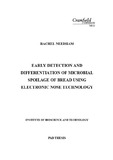JavaScript is disabled for your browser. Some features of this site may not work without it.
| dc.contributor.advisor | Magan, Naresh | en_UK |
| dc.contributor.author | Needham, Rachel | en_UK |
| dc.date.accessioned | 2005-11-23T13:48:32Z | |
| dc.date.available | 2005-11-23T13:48:32Z | |
| dc.date.issued | 2004-08 | en_UK |
| dc.identifier.uri | http://hdl.handle.net/1826/786 | |
| dc.description.abstract | This study investigated the potential for use of electronic noses (e-noses) for early rapid detection and differentiation of bread spoilage before visible signs of growth occur. After 24 h incubation at 25°C it was possible to distinguish Penicillium verrucosum, Aspergillus ochraceus, and Pichia anomala from 3 different species of filamentous fungi before visible growth was observed on unmodified wheat agar using a conducting polymer based e-nose (BH114). Discrimination of controls was possible after 48 h. The BH114 e-nose was able to differentiate between Pseudomonas fragi, Saccharomyces cerevisiae and P. verrucosum growing on 0.97 aw modified flour-based media after only 24 h. The BH114 e-nose was able to discriminate between P. fragi and S. cerevisiae growing in broth cultures and between different aw controls in exponential growth (13.5 h). Discrimination of Staphylococcus aureus growing in different aw broths and from uninoculated controls was achieved after 4.5 h. The BH114 e-nose was also able to detect and differentiate microbial spoilage in situ using bread analogues. Discrimination was improved using an incubation temperature of 25°C when compared to 15°C. Discrimination of microbial and physiological (enzymic) spoilage of bread analogues was possible using e-nose technology, cfu counts and gas chromatograph-mass spectrometry (GC-MS) using an initial population of 106 spores/cells ml-1. After 48 h differentiation of the spoilage types and between some of the microbial spoilage organisms was possible using the e-nose. A significant increase in populations was noted between 24 and 48 h. There were significant differences between microbial populations detected after 48 and 72 h. Analysis of volatile compounds produced, using GC-MS, showed that after 24 h P. anomala was the only treatment to produce 2-propanol, ethyl acetate, and pentanol. P. anomala also produced greater amounts of 3-methylbutanol when compared to P. verrucosum, B. subtilis, lipoxygenase spoilage and controls. Differentiation between toxigenic and non-toxigenic strains of Aspergillus parasiticus in vitro was not achieved. However, in vitro on unmodified 2% wheat agar it was possible to differentiate a non-toxigenic P. verrucosum strain from 4 citrinin producing strains and controls using the BH114 e-nose. On bread analogues it was possible to discriminate two ochratoxin A (OTA) producing P. verrucosum strains after 24 h using an initial population of 106 spore ml-1. Increased incubation resulted in only controls being discriminated. Using a lower initial population of 103 spores ml-1 only controls were discriminated after 24 h. However, after 48 h an OTA producing strain could also be differentiated. The potential for use of e-noses as a tool for screening novel antioxidants was also investigated. It was possible to differentiate between broth samples with and without the antioxidants propyl paraben and butylated hydroxyanisole using both the conductance based e-nose (BH114) and a metal oxide and metal ion based e-nose (NST3220 lab emission analyser). When samples without antioxidant were removed it was possible to differentiate treatments containing antioxidant that had been inoculated with micro-organism and those that had not. The e-noses were also able to discriminate between sample times. Microbial populations and carbon dioxide levels increased with incubation time. P. verrucosum and P. anomala populations were greater in treatments without antioxidant whereas B. subtilis populations were greater in 0.97 aw treatments containing antioxidant. CO2 production was greater in inoculated treatments without an antioxidant except at 0.95 aw P. verrucosum produced greater volumes in the presence of the antioxidant. Using natural bread cross validation studies of 4 unknown contaminants (P. anomala, P. verrucosum and B. subtilis and controls) was performed. This showed that using initial populations of 103 spores/cells ml-1 the BH114 e-nose was able to differentiate between all the unknown treatments after 48 h and the NST3220 lab emission analyser after 72 h. CO2 production could be used to detect controls but it was not possible to differentiate between the micro-organisms. | en_UK |
| dc.format.extent | 1883 bytes | |
| dc.format.extent | 2666216 bytes | |
| dc.format.mimetype | text/plain | |
| dc.format.mimetype | application/pdf | |
| dc.language.iso | en_UK | en_UK |
| dc.publisher | Cranfield University | en_UK |
| dc.title | Early detection and differentiation of microbial spoilage of bread using electronic nose technology | en_UK |
| dc.type | Thesis or dissertation | en_UK |
| dc.type.qualificationlevel | Doctoral | |
| dc.type.qualificationname | PhD | |
| dc.publisher.department | Cranfield University at Silsoe; Institute of BioScience and Technology |
